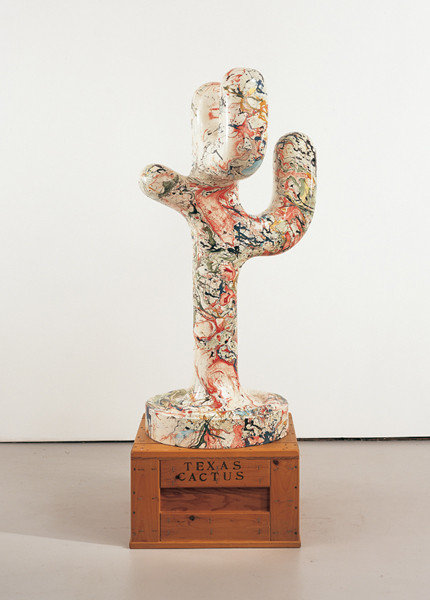H.C. Westermann
dal 12/9/2007 al 2/11/2007
Segnalato da
12/9/2007
H.C. Westermann
Zwirner & Wirth, New York
Westermann's sculptures reveal not only the influence of craft traditions, but also of varied art historical precedents. The artist's ability to convey subtle and uncanny effects through the presentation of seemingly simple objects has often led critics to compare his work to that of Surrealist-inspired artists such as Joseph Cornell.

Solo exhibition
Opening on September 13, 2007, Zwirner & Wirth will present a select survey of sculptures by the influential American artist H.C. Westermann. The exhibition brings together a group of ten key works that exemplify his innovative use of traditional craft techniques to create a body of sculptural work that remains uniquely situated in the canon of 20th Century art.
From the late 1950s until his death in 1981, Westermann worked with a number of materials and formal devices to address a range of personal, literary, artistic, and pop-cultural references. The artist’s sculptural oeuvre is distinguished by its intricate craftsmanship, in which wood, metal, glass, and other materials are laboriously hand-tooled, and by its ability to convey an offbeat, often humorous, individualistic sensibility.
Westermann’s sculptures reveal not only the influence of craft traditions, but also of varied art historical precedents. The artist’s ability to convey subtle and uncanny effects through the presentation of seemingly simple objects has often led critics to compare his work to that of Surrealist-inspired artists such as Joseph Cornell. However, Westermann’s work encompasses elements from a broad and diverse range of artistic practices, including Assemblage, Dada, and Folk Art. His sculptures, moreover, point to minimal and post-minimal art of the late 1960s and beyond, in terms of their rigorous craftsmanship, formal sophistication, unconventional use of materials, and sense of humor. His work has thus appealed to successive generations of artists, among them Bruce Nauman, who created a work inspired by the artist titled Westermann’s Ear (1967; Museum Ludwig Collection, Cologne), and Donald Judd, who wrote in 1963 upon viewing his work, “It would seem that Westermann is one of the best artists around…It is obvious that Surrealist sources could be found for many of Westermann’s ideas. It is just as obvious that the objects are something new.”[1]
The earliest sculptures in the exhibition at Zwirner & Wirth are two life-sized figures that resemble a pair of B-movie robots: The Silver Queen (1960), made from wood coated in silver paint, and a found metal weather vent, and Swingin’ Red King (1961), comprised of stacked pine moldings that have been meticulously painted in slick red enamel. Other works on view exemplify Westermann’s mastery of carpentry and use of unpainted wood as an expressive material. These include Homage to American Art (Dedicated to Elie Nadelman) (1966), a mysterious, wooden implement with a shovel handle that hangs from a mount, and Little Egypt (1969), which presents a handcrafted wooden door and its frame on a pedestal. While his sculptures form a link to earlier eras of American craftsmanship, they reveal a complex artistic sensibility, for Westermann’s work subtly touches on the formal, conceptual, and political issues that preoccupied him as an artist and as a citizen.
Clean Air, for example, is a work from 1964 that presents a series of incrementally-sized wood and plate glass boxes set into one another. Though it could be read as a minimal work, Clean Air also conveys Westermann’s concern with environmental issues. Another sculpture, titled Death Ship of No Port with a List (1969), is comprised of a wooden boat set in a coffin-like case and belongs to a series of “Death Ship” works by the artist that deal with his experience of war (Westermann served in the Marine Corps during World War II and in the Korean War), revealing a sense of disillusionment with political, institutionalized brutality. Later works, such as Hutch the One Armed Astro-Turf Man with a Defense (1976), a figure covered in Astro-Turf with a carved wood boxing glove for a head, and Texas Cactus (1979-80), an oversized wooden cactus on a pedestal, painted in colorful, candy-coated swirls of enamel, exemplify Westermann’s humorous pop-cultural sensibilities and his utterly experimental use of materials.
The work of Horace Clifford Westermann (1922-1981) was steadily exhibited over the course of the artist’s career at the Kansas City Art Institute (1966 and 1970), University Art Museum, University of California, Berkeley (1971); the São Paulo Bienal (1973 and 1979); the Venice Biennale (1976); and the Serpentine Gallery, London (1980); and posthumous exhibitions of his work have taken place at the Art Institute of Chicago (1987); the Contemporary Museum, Honolulu (1994), among other venues. Major retrospective exhibitions of his work were organized by the Los Angeles County Museum of Art (1969); the Whitney Museum of American Art (1978-1979); and, more recently, the Museum of Contemporary Art, Chicago, which traveled to the Hirshhorn Museum and Sculpture Garden, Washington, DC; the Museum of Contemporary Art, Los Angeles; and the Menil Collection, Houston (2001-2003).
Opening on September 13, 2007
Zwirner & Wirth
32 East 69th Street - New York
Free admission



